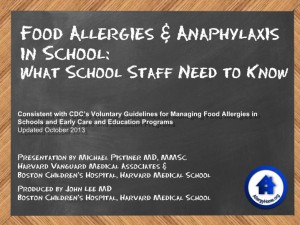 PREVIOUS MYTH:
Advisory statements don’t mean anything. They are just there to protect a company from liability.
PREVIOUS MYTH:
Advisory statements don’t mean anything. They are just there to protect a company from liability.
 NEXT MYTH:
Give antihistmaines first for anaphylaxis
NEXT MYTH:
Give antihistmaines first for anaphylaxis PREVIOUS MYTH:
Advisory statements don’t mean anything. They are just there to protect a company from liability.
PREVIOUS MYTH:
Advisory statements don’t mean anything. They are just there to protect a company from liability.
 NEXT MYTH:
Give antihistmaines first for anaphylaxis
NEXT MYTH:
Give antihistmaines first for anaphylaxis
 Staff Training: Food Allergies & Anaphylaxis in School – What School Staff Need to Know
Staff Training: Food Allergies & Anaphylaxis in School – What School Staff Need to Know
This 30 minute module is designed to assist the school nurse in staff training of management of life-threatening allergic reactions and increase food allergy awareness for all school staff including teachers, food service personnel, administrators, aides, specialists, coaches, bus drivers, custodians and others.
“All anaphylactic reactions have skin symptoms.”
Although skin symptoms occur in most cases of food induced anaphylaxis, 10 to 20% of cases have no skin findings.
This is an important fact that anyone responsible for caring for a child with a food allergy or other causes of anaphylaxis should be aware of. The lack of skin symptoms should not delay treatment of anaphylaxis. Review the emergency care plans for the children that you are responsible with your school nurse or healthcare provider, know the symptoms of anaphylaxis, and know your role in your school’s emergency protocol.
All information contained on the Schools.AllergyHome.org website is intended for informational and educational purposes. The information provided on this website is not intended to be a replacement or substitute for professional medical advice. Any information that you have received from Schools.AllergyHome.org should be verified with your licensed health care provider. Furthermore, decisions regarding medical care should not be based solely upon the content of this website but made after discussions with your health care provider. Consumers should never disregard or delay seeking medical advice due to the content of this site.
Your use of this site does not create a patient-physician relationship between you and AllergyHome.org.
Medical information changes constantly. Therefore the information on this site or on the linked websites should not be considered current, complete or exhaustive, nor should you rely on such information to recommend a course of treatment for you or any other individual. Reliance on any information provided on this site or any linked websites is solely at your own risk.
Please note that AllergyHome is not affiliated with Boston Children’s Hospital